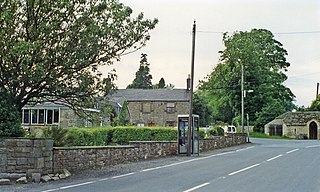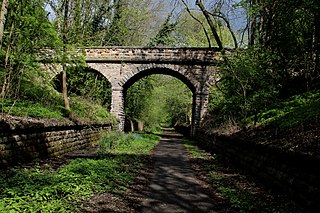
The Harrogate line is a passenger rail line through parts of North Yorkshire and the West Yorkshire area of northern England connecting Leeds to York by way of Harrogate and Knaresborough. Service on the line is operated by Northern, with a few additional workings by London North Eastern Railway starting and terminating at Harrogate. West Yorkshire Metro's bus and rail MetroCard ticket is available for journeys between Leeds and Harrogate.

Malton railway station is a Grade II listed station which serves the towns of Malton and Norton-on-Derwent in North Yorkshire, England. Situated on the York-Scarborough Line, it is operated by TransPennine Express, who provide all passenger train services. Once an interchange between four lines, Malton station is now only served by trains operating between York and Scarborough. The station itself is south of the River Derwent, and is actually in the town of Norton in the East Riding of Yorkshire, which for many years was in a different county to Malton.

Barnoldswick railway station was the only railway station on the Midland Railway's 1-mile-64-chain (2.9 km) long Barnoldswick Branch in the West Riding of Yorkshire in England. It served the market town of Barnoldswick, which was in West Riding of Yorkshire at the time. The line left the Leeds and Bradford Extension Railway at Barnoldswick Junction 55 chains from Earby railway station. The line through the junction was on a 20-chain radius after which it converged to a single track and ran in a straight but undulating line to Barnoldswick. The passenger train that ran back and forth between Barnoldswick and Earby was known locally as the 'Barlick Spud' or 'Spudroaster'. The real reason for the name is lost in time, but the two versions that were commonly recited are that the original branch locomotive was so small it looked like a portable potato roaster used by a local vendor or that the journey time was the same as that taken to roast a potato in the locomotive's firebox.

Holtby railway station was a station on the York to Beverley Line in North Yorkshire, England. It opened as Gate Helmsley in 1848 and was renamed Holtby in 1872. Passenger services ended in 1939 and goods services in 1951.
There are 22 disused railway stations on the Bristol to Exeter line between Bristol Temple Meads and Exeter St Davids. The line was completed in 1844 at which time the temporary terminus at Beambridge was closed. The most recent closure was Tiverton Junction which was replaced by a new station} on a different site in 1986. 12 of the disused stations have structures that can still be seen from passing trains.
Great Horton railway station was a railway station on the Queensbury-Bradford section of the Queensbury Lines which ran between Bradford, Keighley and Halifax via Queensbury. The station opened for passengers in 1878 and closed on 23 May 1955 but remained open to goods with full staff until 28 June 1965 before it was closed, then demolished and the branch line tracks ripped up.
Penton railway station served the parish of Penton from 1862 to 1969 on the Border Union Railway.

Christon Bank railway station served the village of Christon Bank, Northumberland, England from 1847 to 1965 on the East Coast Main Line.

Copmanthorpe railway station served the village of Copmanthorpe, North Yorkshire, England from 1839 to 1959 on the York to Normanton line. The line also became part of the East Coast Main Line at various periods. The station was moved and substantially rebuilt halfway through its working life.

Nidd Bridge railway station served the village of Nidd, North Yorkshire, England from 1848 to 1964 on the Leeds-Northallerton Railway.

Scholes railway station was a station in Scholes, Leeds, West Yorkshire, England, on the Cross Gates–Wetherby line. It opened on 1 May 1876 and closed on 6 January 1964. The former station building is now a restaurant, which from 1984 to 1999 used a Mk 1 railway carriage as extra rooms. The latter is now restored and in use on the Keighley and Worth Valley Railway.

Thorner railway station was a station in Thorner, West Yorkshire, England, on the Cross Gates–Wetherby line. It opened on 1 May 1876 and closed on 6 January 1964. It served Thorner village immediately south of the station as well as the village of Scarcroft a mile to the west. The station was originally called Thorner & Scarcroft, in 1885 it was renamed Scarcroft for some time before reverting to the old name, and in 1901 the name was finally shortened to Thorner.

Hessay railway station served the village of Hessay, North Yorkshire, England from 1849 to 1964 on the Harrogate line.

Hopperton railway station served the village of Hopperton, North Yorkshire, England from 1848 to 1962 on the Harrogate line.

Goldsborough railway station served the village of Goldsborough, North Yorkshire, England from 1850 to 1965 on the Harrogate line. The station was over 13 miles (21 km) west of York railway station, and nearly 3 miles (4.8 km) east of Knaresborough.

Chollerton railway station served the village of Chollerton, Northumberland, England from 1859 to 1958 on the Border Counties Railway.

Thorp Arch railway station (before 12 June 1961 called Thorp Arch (Boston Spa)) was a station in the parish of Wetherby, West Yorkshire, on the Harrogate–Church Fenton line. It opened on 10 August 1847 and served nearby Thorp Arch as well as Boston Spa. The station closed to passengers on 6 January 1964 and completely on 10 August 1964.

Newton Kyme railway station was a railway station on the former Harrogate–Church Fenton line, serving the village of Newton Kyme near Tadcaster in North Yorkshire. It handled freight and passenger traffic.

Spofforth railway station was a station on the Harrogate–Church Fenton line in Spofforth, North Yorkshire.

Sexhow railway station was a railway station built to serve the hamlet of Sexhow in North Yorkshire, England. The station was on the North Yorkshire and Cleveland's railway line between Picton and Stokesley, which opened in 1857. The line was extended progressively until it met the Whitby & Pickering Railway at Grosmont. Sexhow station was closed in 1954 to passengers and four years later to goods. The station was located 13 miles (21 km) south of Stockton, and 3.75 miles (6.04 km) west of Battersby railway station.

















